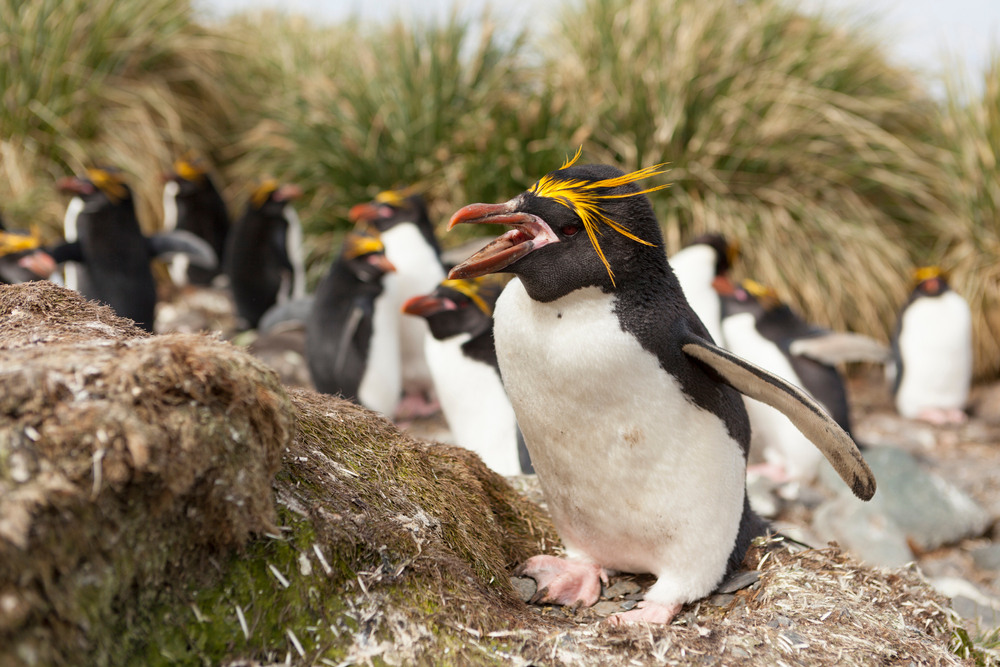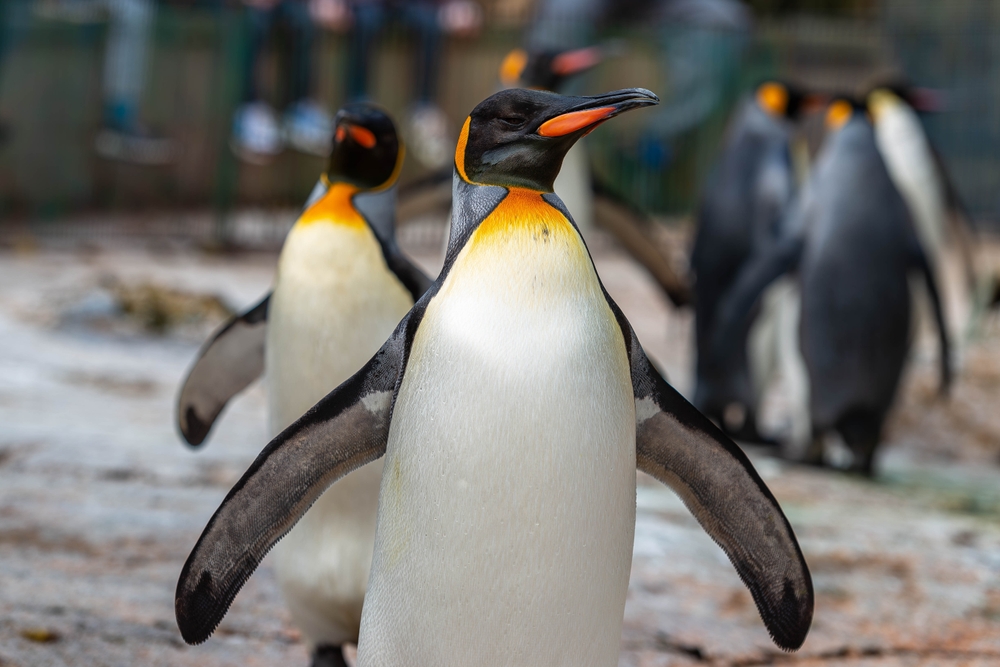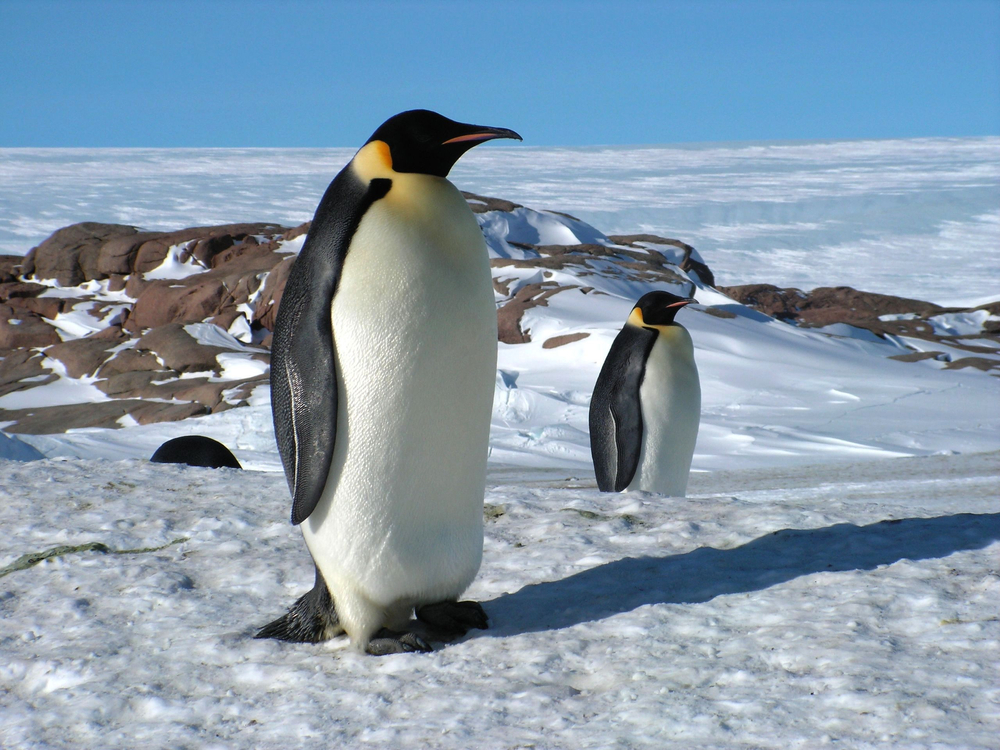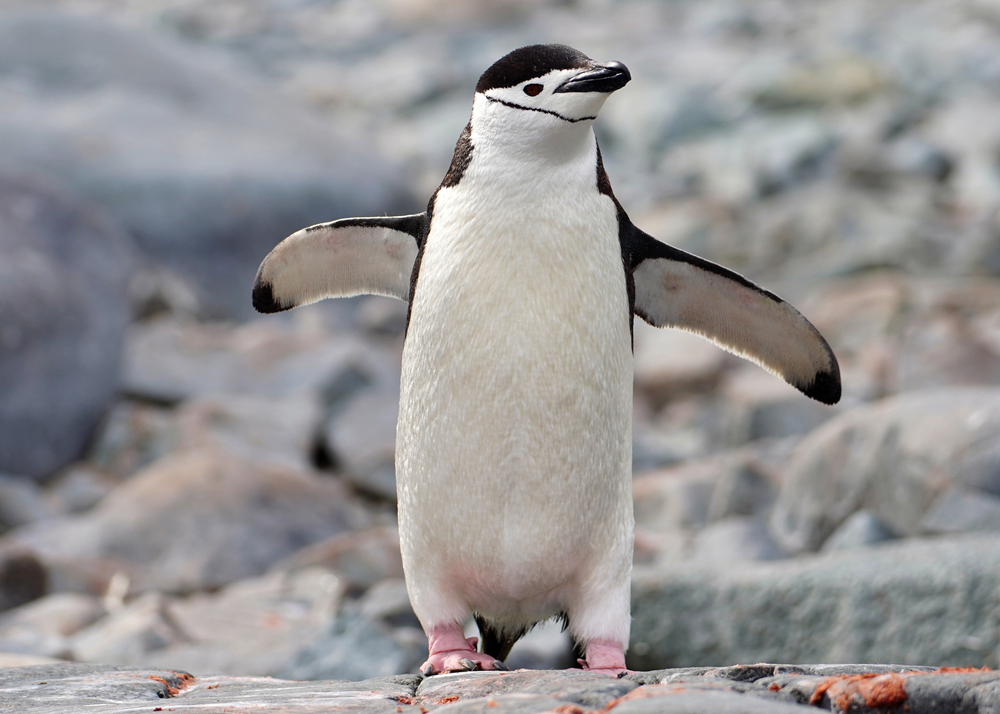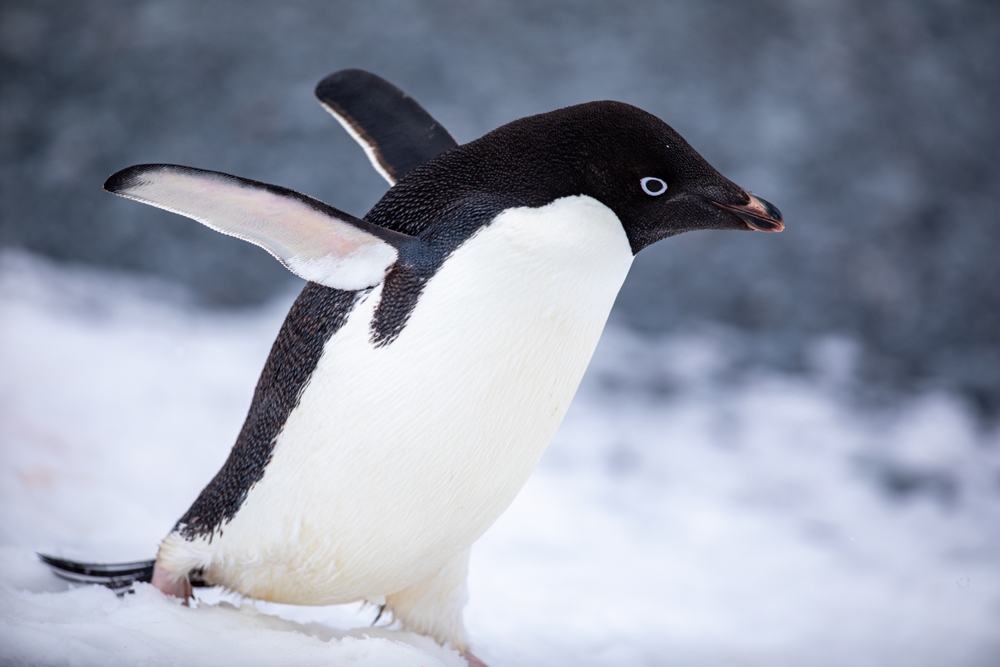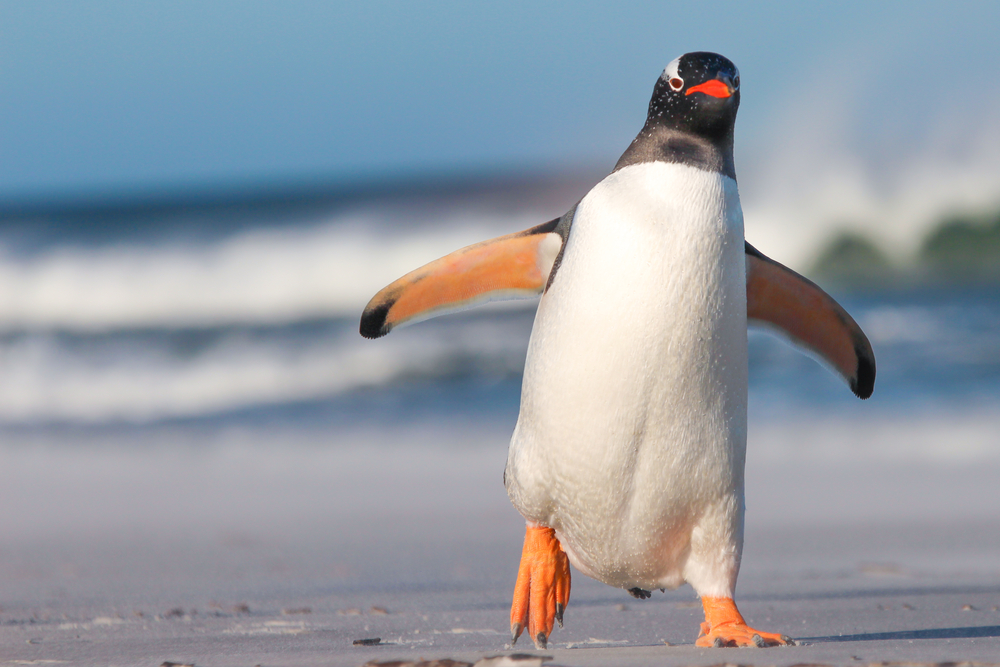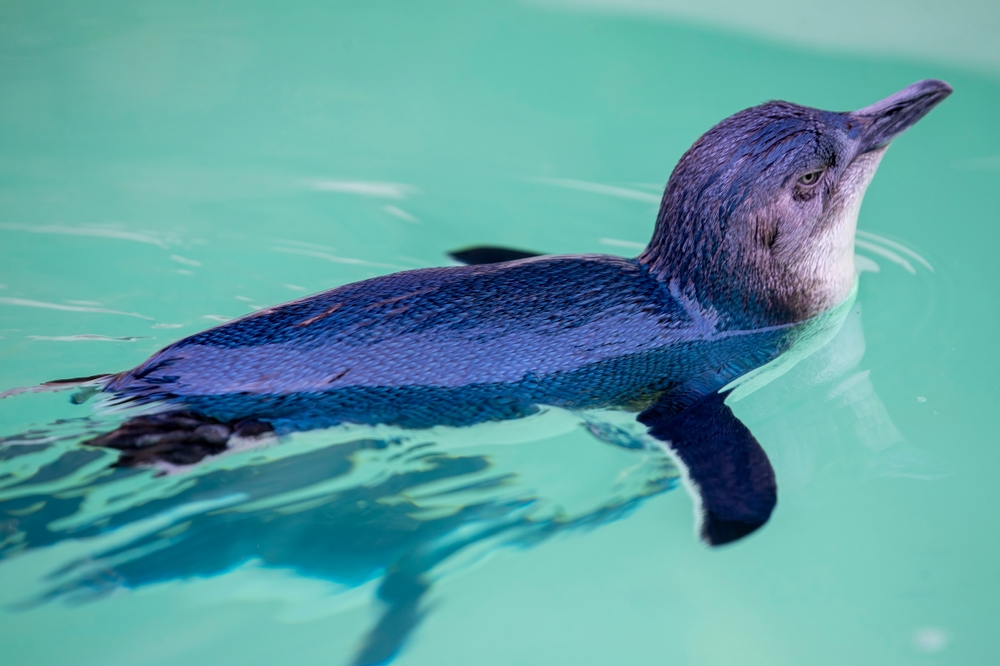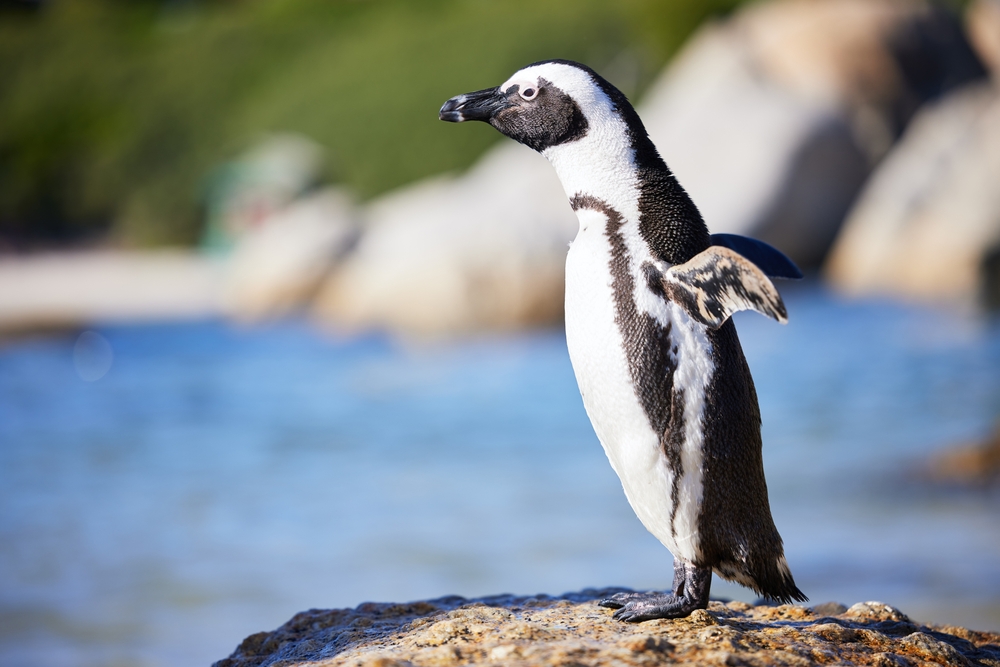The Macaroni Penguin’s closest relatives are other crested penguins (Eudyptes genus), particularly the Royal Penguin(Eudyptes schlegeli). Some scientists even consider Royal Penguins a color variation of Macaronis, as they are nearly identical except for their white face.
About
The Macaroni Penguin (Eudyptes chrysolophus) is a striking crested penguin of the Spheniscidae family, best known for its flamboyant yellow-orange crest feathers that fan out above its eyes. Found on sub-Antarctic islands and the Antarctic Peninsula, it forms some of the largest penguin colonies in the world, with breeding grounds on South Georgia, the Falklands, the South Orkneys, and the South Shetlands.
Macaroni Penguins stand about 70 centimeters (28 inches) tall and weigh 4.5 to 6.5 kilograms (10 to 14 pounds). Their plumage follows the classic penguin pattern of black upperparts and white underparts, contrasted by the vivid golden crest and red eyes. This bold appearance, combined with their noisy colonies, makes them one of the most recognizable penguins.
They are skilled divers, capable of reaching depths over 200 feet (60 meters) while pursuing prey. Their diet consists mainly of Antarctic krill, though they also consume fish and squid. As one of the largest consumers of krill in the Southern Ocean, Macaroni Penguins play a critical ecological role in marine food webs.
Breeding occurs during the austral summer in dense colonies on rocky, cliff-lined shores. Females typically lay two eggs, but the first is often much smaller and usually does not survive, leaving the second as the main chick to be raised. Both parents take turns incubating and feeding the chick, which joins crèches with others before fledging.
Despite their vast numbers, the species is classified as Vulnerable due to population declines linked to climate change, reduced prey availability, and human impacts on marine ecosystems.
With their dazzling crests, bustling colonies, and ecological importance, Macaroni Penguins stand out as one of the Southern Ocean’s most distinctive and charismatic seabirds.
Physical Characteristics
Macaroni Penguins are medium-sized crested penguins, instantly recognizable by their flamboyant golden-yellow crest feathers. They are among the most numerous penguin species in the world.
-
Coat/Plumage: Their back, head, and flippers are black with a bluish sheen, while the chest and belly are pure white. A bold line separates the dark face from the white underparts.
-
Face: They have a black face with bright red eyes and a strong reddish-orange bill. Distinctive golden-yellow crest feathers extend from the forehead above each eye, sweeping back across the head.
-
Body: Stocky and robust, adapted for maneuverability in the water and stability on rocky, uneven terrain.
-
Flippers: Black on the outside and white underneath, used like paddles to power through the water.
-
Feet: Pink with black claws, webbed for swimming and used to grip rocky nesting grounds.
-
Tail: Short, stiff, and wedge-shaped, providing balance on land.
Size:
-
Height: About 24 to 28 in (61 to 71 cm).
-
Weight: Typically 8.8 to 14 lbs (4 to 6.5 kg), with males slightly larger than females.
Macaroni Penguins’ flamboyant yellow crests, bright red eyes, and robust build make them one of the most visually striking penguin species. Their dense, waterproof plumage and powerful flippers make them highly skilled swimmers in the rough waters of the Southern Ocean.
Reproduction
The reproductive cycle of the Macaroni Penguin is highly synchronized and adapted to the harsh, rocky environments of the sub-Antarctic islands.
-
Mating and Courtship:
-
Macaroni Penguins are generally monogamous within a breeding season, though pairs may switch mates in following years.
-
Courtship involves loud braying calls, head swinging, flipper displays, and mutual preening.
-
Breeding colonies are enormous, often numbering in the hundreds of thousands of pairs.
-
-
Nesting:
-
They nest in dense colonies on rocky slopes and cliffs, often close to the shoreline.
-
Nests are shallow scrapes lined with stones, grass, or small pebbles.
-
-
Egg Laying and Incubation:
-
Females typically lay two eggs, but the first egg is smaller and often does not survive.
-
The second egg is larger and more likely to hatch successfully.
-
Both parents share incubation duties, alternating shifts of about 7–12 days.
-
Incubation lasts about 33 to 37 days.
-
-
Chick Development:
-
Chicks hatch covered in gray or brown down.
-
Parents brood them continuously for the first 3–4 weeks, feeding them through regurgitation.
-
-
Crèche and Independence:
-
After 3–4 weeks, chicks join crèches, or groups of young penguins, for safety and warmth.
-
At around 9 to 10 weeks, chicks fledge, molting into waterproof juvenile plumage before heading out to sea.
-
Macaroni Penguins’ reliance on the survival of the second egg and their dense colonial nesting strategy are distinctive reproductive traits, ensuring high chick survival in crowded and challenging environments.
Lifespan
Macaroni Penguins, one of the most abundant penguin species, thrive on sub-Antarctic islands, yet their lifespan reflects the pressures of life in large colonies and at sea.
-
Lifespan in the Wild:
Macaroni Penguins typically live 8 to 15 years, though some individuals can reach up to 20 years under favorable conditions. Many chicks and juveniles fail to survive their first year due to predation, starvation, or harsh weather. -
Lifespan in Captivity:
In aquariums and managed care facilities, Macaroni Penguins may live longer, often reaching 20 years or more, thanks to steady food supplies and veterinary care.
Threats to the Macaroni Penguin:
-
Predation: Eggs and chicks are preyed upon by skuas, sheathbills, and giant petrels, while adults at sea risk attacks from leopard seals and killer whales.
-
Food Availability: Their survival depends on the abundance of krill, small fish, and squid. Commercial fishing and climate-driven changes in ocean productivity can impact these food sources.
-
Climate Change: Warming seas and shifting prey distribution threaten colony stability and chick survival.
-
Human Disturbance: While many colonies are remote, increased tourism and research activity in sub-Antarctic regions can disrupt nesting grounds.
Despite being one of the most numerous penguin species, the Macaroni Penguin is considered Vulnerable by the IUCN due to rapid population declines linked to climate change and food scarcity.
Eating Habits
Macaroni Penguins are carnivorous seabirds that feed primarily on the abundant marine life of the Southern Ocean.
-
Diet:
Their diet is dominated by Antarctic krill, but they also consume small fish and squid depending on seasonal availability. In some regions, krill may make up more than 90% of their food intake. -
Foraging Strategy:
Macaronis are pursuit divers, using their strong flippers to chase prey underwater. They typically forage at depths of 50 to 200 ft (15 to 60 m) but are capable of diving over 300 ft (100 m) when needed. -
Hunting Behavior:
They often feed in large groups, synchronizing dives to target massive swarms of krill. This cooperative hunting increases efficiency and reduces individual risk from predators. -
Feeding the Young:
Parents carry food back in their stomachs and regurgitate partially digested krill, fish, or squid to feed their chicks. During chick-rearing, adults must balance frequent foraging trips with protecting the young. -
Seasonal Variation:
During the breeding season, krill is the dominant prey, while in winter, small fish and squid play a larger role in their diet.
The Macaroni Penguin’s dependence on krill makes it highly vulnerable to environmental change and commercial fishing pressures. Despite being one of the most numerous penguin species, their populations are at risk if krill stocks decline.
Uniqueness
The Macaroni Penguin (Eudyptes chrysolophus) is one of the most striking and abundant penguin species, with several traits that set it apart:
-
Golden Crests: Their flamboyant yellow-orange crest feathers sweeping from the forehead above each eye are their most iconic feature, giving them a bold, “ornamental” look.
-
Most Numerous Penguin: With an estimated population once exceeding 11 million pairs, they are among the most abundant penguin species, though numbers have declined in recent decades.
-
Massive Colonies: Breeding colonies can number in the hundreds of thousands, creating some of the largest seabird gatherings on Earth.
-
Egg Strategy: They typically lay two eggs, but the first, smaller egg is almost always lost, with survival usually focused on the second, larger egg.
-
Harsh Nesting Grounds: They breed on steep, rocky, and exposed slopes of sub-Antarctic islands, requiring great agility to reach their nesting sites.
-
Krill Specialists: Few penguin species rely so heavily on krill; this dietary focus ties their population health directly to ocean productivity and climate change.
-
Name Origin: Their name comes from 18th-century sailors who thought their yellow crests resembled the flamboyant “Macaroni” fashion style of the era in Europe.
The Macaroni Penguin’s bright crests, enormous colonies, and unique reproductive strategy make it one of the most distinctive and ecologically important penguin species in the Southern Ocean.
Be the First to Share Photos of This Species.
FAQ’s
1. What is the species closest to the Macaroni Penguin?
2. How does the Macaroni Penguin compare to other penguins?
Macaroni Penguins are medium-sized, smaller than Emperor and King Penguins but larger than Little Blue Penguins. They stand out for their flamboyant yellow crests, enormous colonies, and their unusual egg strategy—where the smaller first egg rarely survives. They are also among the most abundant penguin species, though populations are now declining.
3. What national parks provide an opportunity to see the Macaroni Penguin?
Macaroni Penguins are found on sub-Antarctic islands and parts of the Antarctic Peninsula, many of which are protected:
-
South Georgia and South Sandwich Islands (UK Overseas Territory) – home to some of the largest colonies.
-
Crozet and Kerguelen Islands (French Southern and Antarctic Lands) – important protected breeding areas.
-
Marion and Prince Edward Islands (South Africa) – part of a marine protected area.
-
South Orkney Islands (Antarctica, ASPAs under the Antarctic Treaty System) – smaller but important colonies.
These protected regions and marine reserves are key strongholds for Macaroni Penguin populations.



































































